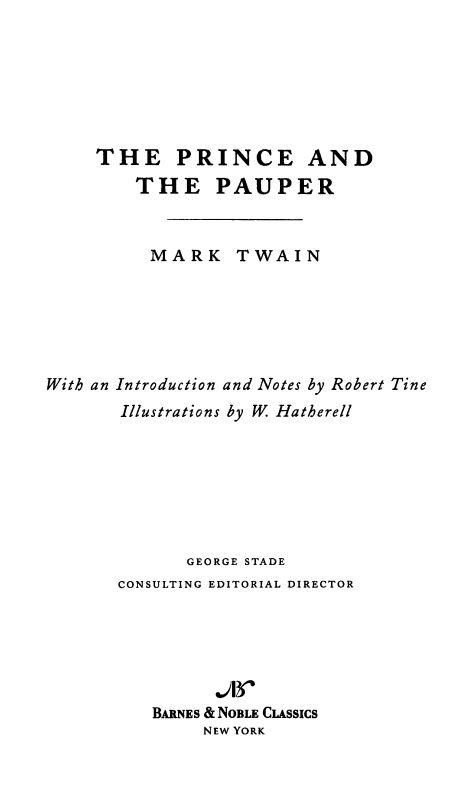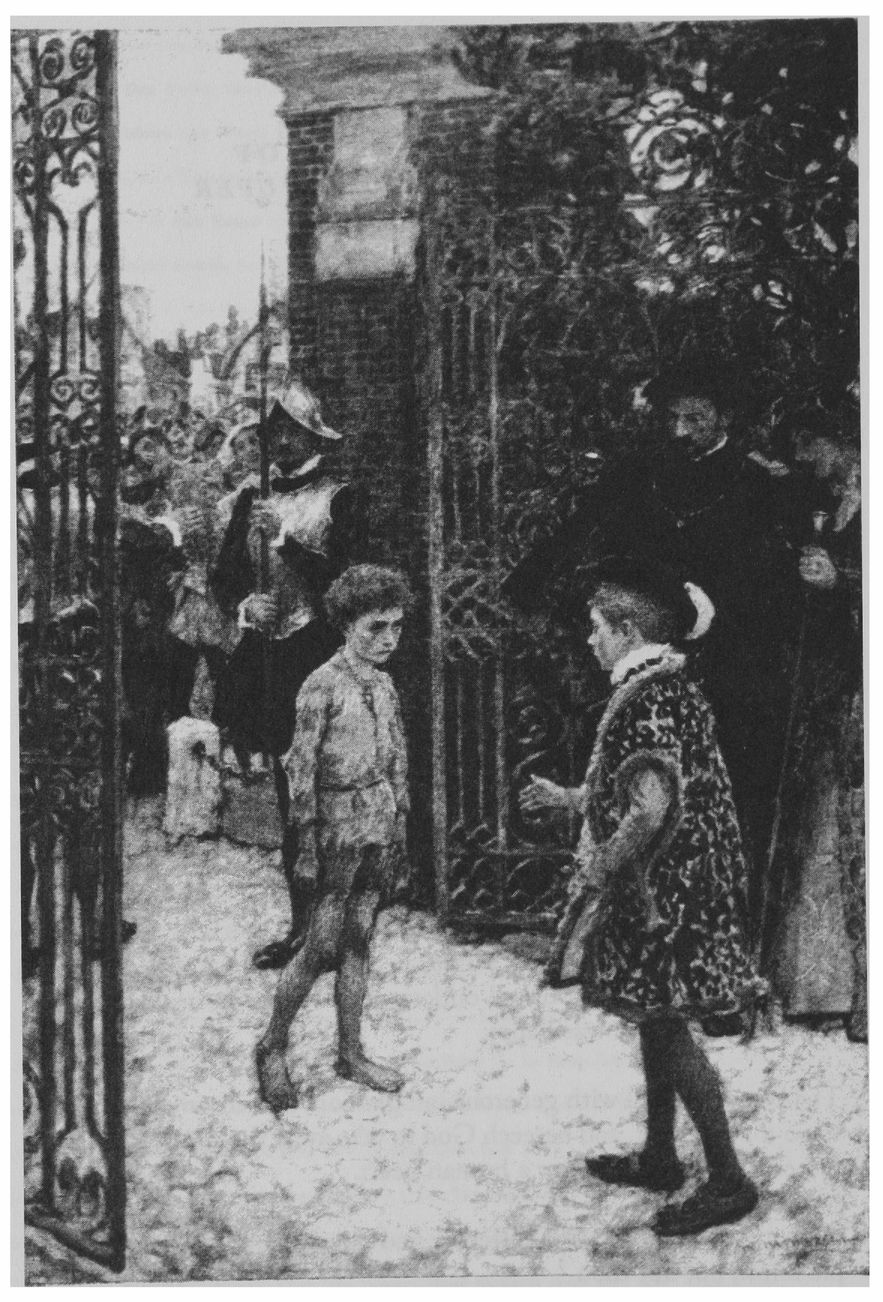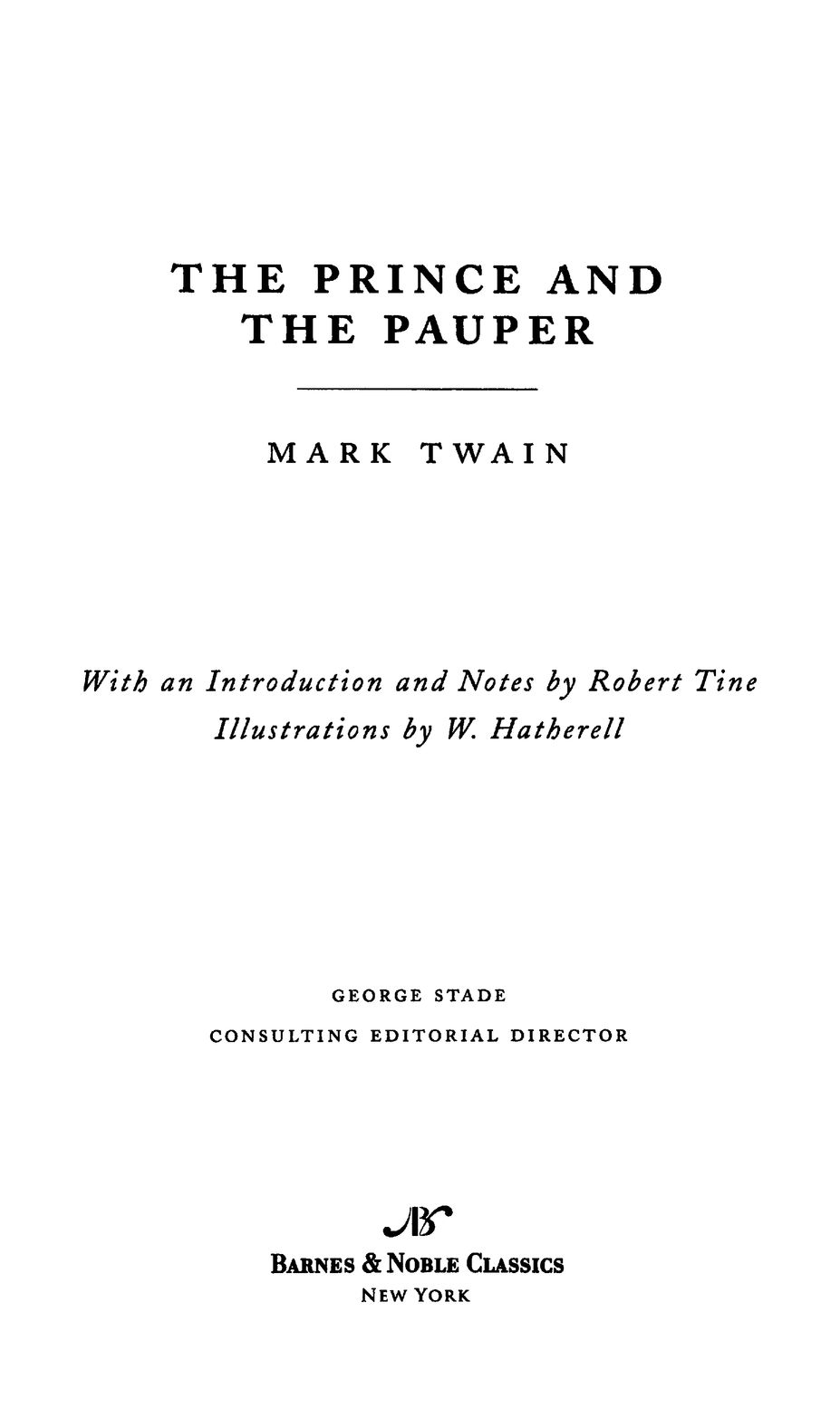Prince and the Pauper (Barnes & Noble Classics Series)
Read Prince and the Pauper (Barnes & Noble Classics Series) Online
Authors: Mark Twain

BOOK: Prince and the Pauper (Barnes & Noble Classics Series)
3.24Mb size Format: txt, pdf, ePub

Table of Contents
FROM THE PAGES OF
THE PRINCE AND THE PAUPER
THE PRINCE AND THE PAUPER
In the ancient city of London, on a certain autumn day in the second quarter of the sixteenth century, a boy was born to a poor family of the name of Canty, who did not want him. On the same day another English child was born to a rich family of the name of Tudor, who did want him. All England wanted him too. (page 11)
“When I am king, they shall not have bread and shelter only, but also teachings out of books; for a full belly is little worth where the mind is starved, and the heart.” (page 27)
“And so I am become a knight of the Kingdom of Dreams and Shadows!” (page 76)
“In truth, being a king is not all dreariness—it hath its compensations and conveniences.” (page 94)
Pleasant thoughts came at once; life took on a cheerfuler seeming. He was free of the bonds of servitude and crime, free of the companionship of base and brutal outlaws; he was warm, he was sheltered; in a word, he was happy. (page 123)
The boy was filled with generous indignation, and commanded her to go to her closet, and beseech God to take away the stone that was in her breast, and give her a human heart. (page 180)
“What dost thou know of suffering and oppression? I and my people know, but not thou.” (page 210)



Published by Barnes & Noble Books
122 Fifth Avenue
New York, NY 10011
122 Fifth Avenue
New York, NY 10011
The Prince and the Pauper
was first published in 1881.
was first published in 1881.
Published in 2004 by Barnes & Noble Classics with new Introduction,
Notes, Biography, Chronology, Inspired by, Comments & Questions,
and For Further Reading.
Notes, Biography, Chronology, Inspired by, Comments & Questions,
and For Further Reading.
Introduction, Notes, and For Further Reading
Copyright © 2004 by Robert Tine.
Note on Mark Twain, The World of Mark Twain and
The Prince and the Pauper,
Inspired by
The Prince and the Pauper,
and Comments & Questions
Copyright © 2004 by Barnes & Noble, Inc.
The Prince and the Pauper,
Inspired by
The Prince and the Pauper,
and Comments & Questions
Copyright © 2004 by Barnes & Noble, Inc.
All rights reserved. No part of this publication may be reproduced or transmitted in any form or by any means, electronic or mechanical, including photocopy, recording, or any information storage and retrieval system, without the prior written permission of the publisher.
Barnes & Noble Classics and the Barnes & Noble Classics colophon are trademarks of Barnes & Noble, Inc.
The Prince and the Pauper
ISBN-13: 978-1-59308-218-5 ISBN-10: 1-59308-218-5
eISBN : 978-1-411-43297-0
LC Control Number 2004107220
Produced and published in conjunction with
Fine Creative Media, Inc.
322 Eighth Avenue
New York, NY 10001
Fine Creative Media, Inc.
322 Eighth Avenue
New York, NY 10001
Michael J. Fine, President and Publisher
Printed in the United States of America
QM
5 7 9 10 8 6 4
MARK TWAIN
Mark Twain was born Samuel Langhorne Clemens on November 30, 1835. When Sam was four years old, his family moved to Hannibal, Missouri, a small town later immortalized in
The Adventures of Tom Sawyer
and
Adventures of Huckleberry Finn.
After the death of his father, twelve-year-old Sam quit school and supported his family by working as a delivery boy, a grocer’s clerk, and an assistant blacksmith until he was thirteen, when he became an apprentice printer. He worked for several newspapers, traveled throughout the country, and established himself as a gifted writer of humorous sketches. Abandoning journalism at points to work as a riverboat pilot, Clemens adventured up and down the Mississippi, learning the 1,200 miles of the river.
The Adventures of Tom Sawyer
and
Adventures of Huckleberry Finn.
After the death of his father, twelve-year-old Sam quit school and supported his family by working as a delivery boy, a grocer’s clerk, and an assistant blacksmith until he was thirteen, when he became an apprentice printer. He worked for several newspapers, traveled throughout the country, and established himself as a gifted writer of humorous sketches. Abandoning journalism at points to work as a riverboat pilot, Clemens adventured up and down the Mississippi, learning the 1,200 miles of the river.
During the 1860s he spent time in the West, in newspaper work and panning for gold, and traveled to Europe and the Holy Land;
The Innocents Abroad
(1869) and
Roughing It
(1872) are accounts of those experiences. In 1863 Samuel Clemens adopted a pen name, signing a sketch as “Mark Twain,” and in 1867 Mark Twain won fame with publication of a collection of humorous writings,
The Celebrated Jumping Frog of Calaveras County and Other Sketches.
After marrying and settling in Connecticut, Twain wrote his best-loved works: the novels about Tom Sawyer and Huckleberry Finn, and the nonfiction work
Life on the Mississippi.
Meanwhile, he continued to travel and had a successful career as a public lecturer.
The Innocents Abroad
(1869) and
Roughing It
(1872) are accounts of those experiences. In 1863 Samuel Clemens adopted a pen name, signing a sketch as “Mark Twain,” and in 1867 Mark Twain won fame with publication of a collection of humorous writings,
The Celebrated Jumping Frog of Calaveras County and Other Sketches.
After marrying and settling in Connecticut, Twain wrote his best-loved works: the novels about Tom Sawyer and Huckleberry Finn, and the nonfiction work
Life on the Mississippi.
Meanwhile, he continued to travel and had a successful career as a public lecturer.
In his later years, Twain saw the world with increasing pessimism following the death of his wife and two of their three daughters. The tone of his later novels, including
The Tragedy of Pudd‘nhead Wilson
and
A Connecticut Yankee in King Arthur’s Court,
became cynical and dark. Having failed as a publisher and suffering losses from ill-advised investments, Twain was forced by financial necessity to maintain a heavy schedule of lecturing. Though he had left school at an early age, his genius was recognized by Yale University, the University of Missouri, and Oxford University in the form of honorary doctorate degrees. He died in his Connecticut mansion, Stormfield, on April 21, 1910.
The Tragedy of Pudd‘nhead Wilson
and
A Connecticut Yankee in King Arthur’s Court,
became cynical and dark. Having failed as a publisher and suffering losses from ill-advised investments, Twain was forced by financial necessity to maintain a heavy schedule of lecturing. Though he had left school at an early age, his genius was recognized by Yale University, the University of Missouri, and Oxford University in the form of honorary doctorate degrees. He died in his Connecticut mansion, Stormfield, on April 21, 1910.
THE WORLD OF MARK TWAIN AND
THE PRINCE AND THE PAUPER
THE PRINCE AND THE PAUPER
| 1835 | Samuel Langhorne Clemens is born prematurely in Florida, Missouri, the fourth child of John Marshall Clemens and Jane Lampton Clemens. |
| 1839 | The family moves to Hannibal, the small Missouri town on the west bank of the Mississippi River that will become the model for the setting of Tom Sawyer and Huckleberry Finn. |
| 1840 | American newspapers gain increased readership as urban populations swell and printing technology improves. |
| 1847 | John Clemens dies, leaving the family in financial difficulty. Sam quits school at the age of twelve. |
| 1848 | Sam becomes a full-time apprentice to Joseph Ament of the Missouri Courier. |
| 1850 | Sam’s brother Orion, ten years his senior, returns to Hannibal and establishes the Journal ; he hires Sam as a compositor. Steamboats become the primary means of transport on the Mississippi River. |
| 1852 | Sam edits the failing Journal while Orion is away. After he reads local humor published in newspapers in New England and the Southwest, Sam begins printing his own humorous sketches in the Journal. He submits “The Dandy Frightening the Squatter” to the Carpet-Bag of Boston, which publishes the sketch in the May issue. |
| 1853 | Sam leaves Hannibal and begins working as an itinerant printer; he visits St. Louis, New York, and Philadelphia. His brothers Orion and Henry move to Iowa with their mother. |
| 1854 | Transcendentalism flourishes in American literary culture; Henry David Thoreau publishes Walden. |
| 1855 | Sam works again as a printer with Orion in Keokuk, Iowa. |
| 1856 | Sam acquires a commission from Keokuk’s Daily Post to write humorous letters; he decides to travel to South America. |
| 1857 | Sam takes a steamer to New Orleans, where he hopes to find a ship bound for South America. Instead, he signs on as an apprentice to river pilot Horace Bixby and spends the next two years learning how to navigate a steamship up and down the Mississippi. His experiences become material for Life on the Mississippi and his tales of Tom Sawyer and Huck Finn. |
| 1858 | Sam’s brother Henry dies in a steamboat accident. |
| 1859 | Samuel Clemens becomes a fully licensed river pilot. |
| 1861 | The American Civil War erupts, putting an abrupt stop to river trade between North and South. Sam serves with a Confederate militia for two weeks before venturing to the Nevada Territory with Orion, who had been appointed by President Abraham Lincoln as secretary of the new Territory. |
| 1862 | After an unsuccessful stint as a miner and prospector for gold and silver, Clemens begins reporting for the Territorial Enterprise in Virginia City, Nevada. |
| 1863 | Clemens signs his name as “Mark Twain” on a humorous travel sketch printed in the Territorial Enterprise. The pseudonym, a riverboat term meaning “two fathoms deep,” connotes barely navigable water. |
| 1864 | After challenging his editor to a duel, Twain is forced to leave Nevada and lands a job with a San Francisco newspaper. He meets Artemus Ward, a popular humorist, whose techniques greatly influence Twain’s writing. |
| 1865 | Robert E. Lee’s army surrenders, ending the Civil War. While prospecting for gold in Calaveras County, California, Twain hears a tale he uses for a story that makes him famous; originally titled “Jim Smiley and His Jumping Frog,” it is published in New York’s Saturday Press. |
| 1866 | Twain travels to Hawaii as a correspondent for the Sacramento Union; upon his return to California, he delivers his first public lecture, beginning a successful career as a humorous speaker. |
| 1867 | Twain travels to New York, and then to Europe and the |
| Holy Land aboard the steamer Quaker City; during five months abroad, he contributes to California’s largest paper, Sacramento’s Alta California, and writes several letters for the New York Tribune. He publishes a volume of stories and sketches, The Celebrated Jumping Frog of Calaveras County and Other Sketches. | |
| 1868 | Twain meets and falls in love with Olivia (Livy) Langdon. His overseas writings have increased his popularity; he signs his first book contract and begins The Innocents Abroad, sketches based on his trip to the Holy Land. He embarks on a lecture tour of the American Midwest. |
| 1869 | Twain becomes engaged to Livy, who acts as his editor from that time on. The Innocents Abroad, published as a subscription book, is an instant success, selling nearly 100,000 copies in the first three years. |
| 1870 | Twain and Livy marry. Their son, Langdon, is born; he lives only two years. |
| 1871 | The Clemens move to Hartford, Connecticut. |
| 1872 | Roughing It, an account of Twain’s adventures out West, is published to enormous success. The first of Twain’s three daughters, Susie, is born. Twain strikes up a lifelong friendship with the writer William Dean Howells. |
| 1873 | Ever the entrepreneur, Twain receives the patent for Mark Twain’s Self-Pasting Scrapbook, an invention that is a commercial success. He publishes The Gilded Age, a collaboration with his neighbor Charles Dudley Warner that satirizes the post-Civil War era. |
| 1874 | His daughter Clara is born. The family moves into a mansion in Hartford in which they will live for the next seventeen years. |
| 1876 | The Adventures of Tom Sawyer is published. |
| 1877 | Twain collaborates with Bret Harte—an author known for his use of local color and humor and for his parodies of Cooper, Dickens, and Hugo—to produce the play Ah Sin. |
| 1880 | Twain invests in the Paige typesetter and loses thousands of dollars. He publishes A Tramp Abroad, an account of his travels in Europe the two previous years. His daughter Jean is born. |
| 1881 | The Prince and the Pauper, Twain’s first historical romance, is published. |
| 1882 | Twain plans to write about the Mississippi River and makes the trip from New Orleans to Minnesota to refresh his memory. |
| 1883 | The nonfiction work Life on the Mississippi is published. |
| 1884 | Adventures of Huckleberry Finn, a book Twain worked on for nearly ten years, is published in England; publication in the United States is delayed until the following year because an illustration plate is judged to be obscene. |
| 1885 | When Adventures of Huckleberry Finn is published in America—by Twain’s ill-fated publishing house, run by his nephew Charles Webster—controversy immediately surrounds the book. Twain also publishes the memoirs of his friend former President Ulysses S. Grant. |
| 1888 | He receives an honorary Master of Arts degree from Yale University. |
| 1889 | He publishes A Connecticut Yankee in King Arthur’s Court, the first of his major works to be informed by a deep pessimism. He meets Rudyard Kipling, who had come to America to meet Twain, in Livy’s hometown of Elmira, New York. |
| 1890 | Twain’s mother dies. |
| 1891 | Financial difficulties force the Clemens family to close their Hartford mansion; they move to Berlin, Germany. |
| 1894 | Twain publishes The Tragedy of Pudd’nhead Wilson, a dark novel about the aftermath of slavery, which sells well, and Tom Sawyer Abroad, which does not. Twain’s publishing company fails and leaves him bankrupt. |
| 1895 | Twain embarks on an ambitious worldwide lecture tour to restore his financial position. |
| 1896 | He publishes Personal Recollections of Joan of Arc and Tom Sawyer, Detective. His daughter Susie dies of spinal meningitis. |
| 1901 | Twain is awarded an honorary doctorate degree from Yale. |
| 1902 | Livy falls gravely ill. Mark Twain’s Huckleberry Finn, a stage adaptation of the novel, opens to favorable reviews. Though he is credited with coauthorship, Twain has little to do with |
| 1903 | the play and never sees it performed. He receives an honorary doctorate degree from the University of Missouri. Hoping to restore Livy’s health, Twain takes her to Florence, Italy. |
| 1904 | Livy dies, leaving Twain devastated. He begins dictating an uneven autobiography that he never finishes. |
| 1905 | Theodore Roosevelt invites Twain to the White House. Twain enjoys a gala celebrating his seventieth birthday in New York. He continues to lecture, and he addresses Congress on copyright issues. |
| 1906 | Twain’s biographer Albert Bigelow Paine moves in with the family. |
| 1907 | Twain travels to Oxford University to receive an honorary Doctor of Letters degree. |
| 1908 | He settles in Redding, Connecticut, at Stormfield, the mansion that is his final home. |
| 1909 | Twain’s daughter Clara marries; the author dons his Oxford robe for the ceremony. His daughter Jean dies. |
| 1910 | Twain travels to Bermuda for his health. He develops heart problems and, upon his return to Stormfield, dies, leaving behind a cache of unpublished work. |
Other books
My Beloved by T.M. Mendes
Merline Lovelace by The Colonel's Daughter
Picture Perfect (Weddings by Design Book #1): A Novel by Thompson, Janice
Hell's Bay by James W. Hall
WalkingHaunt by Viola Grace
Father's Day Murder by Lee Harris
Atticus Claw Lends a Paw by Jennifer Gray
Because the Night by James Ellroy
Coming Up Roses by Catherine Anderson
Once Bitten, Twice Shy by Jennifer Rardin